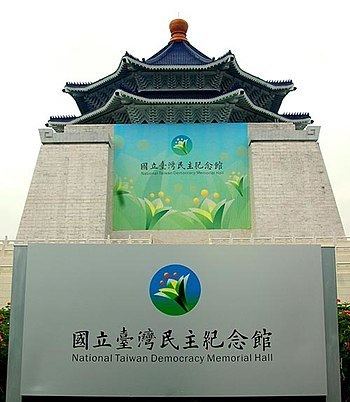Date March 1990 | ||
 | ||
Location | ||
wild lily student movement member
Taiwan's Wild Lily student movement (Chinese: 野百合學運; pinyin: Yě Bǎihé xué yùn) or March student movement was a six-day student demonstration in 1990 for democracy. The sit-in at Memorial Square in Taipei (since rededicated as Liberty Square in commemoration of the movement) was initiated by students from the National Taiwan University. Participation quickly grew to 22,000 demonstrators. The Wild Lily demonstrators sought direct elections of Taiwan's president and vice president and new popular elections for all representatives in the National Assembly.
The demonstration lasted from March 16 to March 22, 1990, coinciding with the inauguration of Lee Teng-Hui on March 21 to a six-year term as president. The election Lee won was one in which only the 671 members of the National Assembly voted, only one party was recognized, and one candidate ran. This process had been characteristic of one-party rule under the Kuomintang and Chiang Kai-shek.
Protesters wore white Formosan lilies and created giant replicas of the flower as a symbol of democracy. Their adoption of the flower as an icon of freedom evoked a long native tradition. Yang Yung-ming, a professor of political science at the National Taiwan University, described it to the Taiwan Review in 2003:
"For years, Taiwanese poets have employed this flower as a symbol of grace and resilience. The aboriginal poet Lin Yi-te, for example, often used it to symbolize the Taiwanese indigenous peoples' primitive purity of spirit, and used the flower's decline to dramatize the desolation and tragedy of their decline. It was Taiwanese literature's use of this wild lily as a metaphor of simplicity and fortitude that inspired its use by those in the student democracy movement."
On the first day of his new term Lee Teng-Hui welcomed fifty students to the Presidential Building. He expressed his support of the students' goals and promised full democracy in Taiwan beginning with reforms to be initiated that summer.
The Wild Lily student movement marked a crucial turning point in Taiwan's transition to pluralistic democracy. Six years later Lee became Taiwan's first popularly elected leader, taking 54% of the vote in an election in which over 95% of eligible voters participated. Democracy supporters continue to gather at Liberty Square every March 21 to commemorate the event. Officials affiliated with the Taiwan Solidarity Union have advocated the movement of Taiwan's Youth Day to March 21 in recognition of the students' achievement.
Taiwan President Chen Shui-Bian, on the eve of the fifteenth anniversary of the ill-fated student democracy protests in China's Tiananmen Square, noted that the Wild Lily student movement had taken place only a year after the events in Beijing. He noted the contrast in the way the governments responded. "The most memorable impression of the Tiananmen incident of June 4th is that of that small, thin person holding up a line of tanks, which was a heroic and disturbing impression," he said. "The March Study Movement, in pressing for the establishment of a national affairs conference, changing the way the Legislative Yuan and the National Assembly are elected and a consensus on realizing the direct election of the president, also set a timetable for reform."
Today Taiwan's national leaders are popularly elected and multiple political parties are legal. The National Assembly voted to disband itself in 2006.
